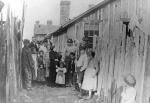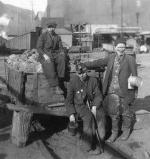Chapter Three: Coal Communities
Asa Packer arrived in Mauch Chunk in the 1830s as an unemployed carpenter, but changed his fortune first by building canal barges and then by forming the Lehigh Valley Railroad to transport coal and compete with the Lehigh Canal. Upon becoming one of the wealthiest figures in the region, Packer, like many other industrial barons, built a lavish mansion. Located in Mauch Chunk, the  Packer Mansion was a Victorian castle full of elaborate rooms and surrounded by luxurious gardens. His home still stands today, as a symbol of the classic American success story. Yet it could also be seen as a cruel monument to the hard work of the many miners, canal boatmen and railroad workers who built Packer's fortune, and who were never able to provide such comfort and security for their own families. To say that life in a typical coal town for a mining family was dramatically different than Packer's would be an understatement - these were two separate worlds.
Packer Mansion was a Victorian castle full of elaborate rooms and surrounded by luxurious gardens. His home still stands today, as a symbol of the classic American success story. Yet it could also be seen as a cruel monument to the hard work of the many miners, canal boatmen and railroad workers who built Packer's fortune, and who were never able to provide such comfort and security for their own families. To say that life in a typical coal town for a mining family was dramatically different than Packer's would be an understatement - these were two separate worlds.
The famous novels and short stories of John O'Hara focused on the world of the anthracite region's ruling classes. Having grown up in
John O'Hara focused on the world of the anthracite region's ruling classes. Having grown up in  Schuylkill County, O'Hara turned his hometown, Pottsville, into the fictional "Gibbsville," examining its shifting class structure and the ethnic and religious tensions that accompanied it. Other cities, such as Wilkes-Barre and Hazleton in
Schuylkill County, O'Hara turned his hometown, Pottsville, into the fictional "Gibbsville," examining its shifting class structure and the ethnic and religious tensions that accompanied it. Other cities, such as Wilkes-Barre and Hazleton in Luzerne County and Scranton in
Luzerne County and Scranton in  Lackawanna County, were centers of great wealth generated by anthracite and its related industries.
Lackawanna County, were centers of great wealth generated by anthracite and its related industries.
Families such as the Pardees, Markles, Coxes, and Scrantons consolidated their mining and railroad interests and became the powerful economic and social elite in the region. They built these cities, controlled the related industries of iron production and transportation, and tied the counties' economies to their anthracite acreage. Perhaps less familiar are towns like Shenandoah and Ashland in Schuylkill county, Nanticoke and Plymouth in Luzerne County, and Olyphant and Taylor in Lackawanna County, but all grew quickly due to the mining of anthracite and the transportation networks that developed to move it.
The rapid population growth of these northeastern Pennsylvania towns was driven to a large extent by the arrival of immigrant workers, creating an ethnic diversity in what is arguably the single most important cultural development of the anthracite revolution. Almost from the beginning, immigrants dominated the ranks of colliery workers. The earliest miners were English and Welsh, then Irish laborers, escaping oppression and the infamous potato famine, swelled the rolls of coal company pay books in the 1850s. Later, at the end of the nineteenth century, southern and eastern Europeans arrived to share the burden of the dangerous colliery jobs.
Just as they sought to control coal fields, transportation routes, and markets, the anthracite companies devised ways to manage, control, and exploit their new workforces, both below and above ground. Many workers were doubly vulnerable to manipulation, because of their status as new arrivals in a foreign country and because there was little employment for them in the anthracite counties outside of mining.
An important element of owner control was the "patch town." Companies built and rented out most of the housing in these towns, owned and stocked the stores, and regulated the flow of money by keeping a tight lid on wages. Owner profits came not just from mining the anthracite but also from a collection of practices that became known as "mining the miners:" gouging the workers and shrinking their paychecks by charging high rates for the company-provided housing and at the company-run stores. If they had trouble with an employee, they could fire him and evict his family, making sure to deduct that month's rent and company store purchases from the wages due him.
This overarching control of the lives of miners and their families served to intimidate workers who might otherwise have been tempted to protest low wages or dangerous working conditions. Eckley Miners Village, built in the 1850s, was a typical patch town: one magazine of the era described it as nothing more than "a vast collection of shanties." For some immigrants, struggling to establish themselves in a new country, life in the patch town may have seemed at least bearable enough to justify their sacrifices.
The famous novels and short stories of
Families such as the Pardees, Markles, Coxes, and Scrantons consolidated their mining and railroad interests and became the powerful economic and social elite in the region. They built these cities, controlled the related industries of iron production and transportation, and tied the counties' economies to their anthracite acreage. Perhaps less familiar are towns like Shenandoah and Ashland in Schuylkill county, Nanticoke and Plymouth in Luzerne County, and Olyphant and Taylor in Lackawanna County, but all grew quickly due to the mining of anthracite and the transportation networks that developed to move it.
The rapid population growth of these northeastern Pennsylvania towns was driven to a large extent by the arrival of immigrant workers, creating an ethnic diversity in what is arguably the single most important cultural development of the anthracite revolution. Almost from the beginning, immigrants dominated the ranks of colliery workers. The earliest miners were English and Welsh, then Irish laborers, escaping oppression and the infamous potato famine, swelled the rolls of coal company pay books in the 1850s. Later, at the end of the nineteenth century, southern and eastern Europeans arrived to share the burden of the dangerous colliery jobs.
Just as they sought to control coal fields, transportation routes, and markets, the anthracite companies devised ways to manage, control, and exploit their new workforces, both below and above ground. Many workers were doubly vulnerable to manipulation, because of their status as new arrivals in a foreign country and because there was little employment for them in the anthracite counties outside of mining.
An important element of owner control was the "patch town." Companies built and rented out most of the housing in these towns, owned and stocked the stores, and regulated the flow of money by keeping a tight lid on wages. Owner profits came not just from mining the anthracite but also from a collection of practices that became known as "mining the miners:" gouging the workers and shrinking their paychecks by charging high rates for the company-provided housing and at the company-run stores. If they had trouble with an employee, they could fire him and evict his family, making sure to deduct that month's rent and company store purchases from the wages due him.
This overarching control of the lives of miners and their families served to intimidate workers who might otherwise have been tempted to protest low wages or dangerous working conditions. Eckley Miners Village, built in the 1850s, was a typical patch town: one magazine of the era described it as nothing more than "a vast collection of shanties." For some immigrants, struggling to establish themselves in a new country, life in the patch town may have seemed at least bearable enough to justify their sacrifices.











